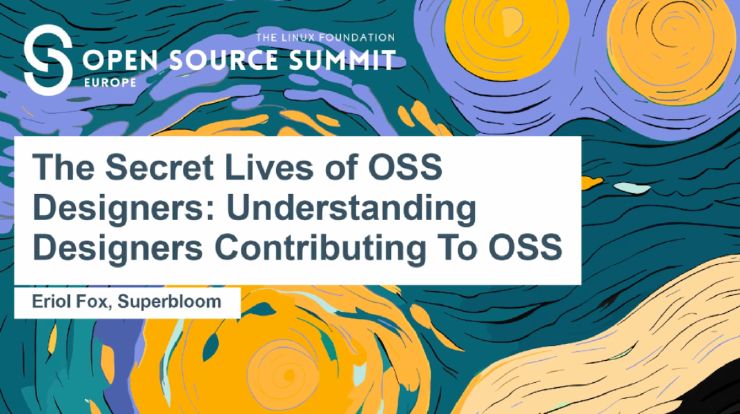
In August 2025, I had the chance to attend Open Source Summit Europe 2025, a flagship event by the Linux Foundation, held in Amsterdam from 25 to 27 August. As a first-time speaker and designer stepping into a developer-dominated space, I joined thousands of contributors, maintainers, and innovators for four days of talks, workshops, and community days focused on advancing open source software. What started with a bit of hesitation quickly turned into an inspiring experience, proving that design has a vital seat at the open source table.
This year, I walked into Open Source Summit Europe 2025 for the very first time, not just as an attendee, but as a speaker. And I’ll admit, I carried a quiet hesitation with me.
As a designer in the world of open source, I’ve learned to expect raised eyebrows. At best, polite confusion: “What’s a designer doing here?” At worst, a cold shoulder. This is especially given that OSS spaces have historically catered to developers. Too often, design is treated as decoration, something that comes after the “real” work is done.
But something shifted at OSSummit. Instead of skepticism, I found curiosity. Instead of dismissal, I found conversations. Contributors and maintainers asked questions, sought out resources, and welcomed design as part of the fabric of open source. For me, it was a reminder that OSS doesn’t just belong to developers. It belongs to anyone willing to help make it stronger, safer, and more usable.
Security as a shared responsibility
One theme echoed through almost every session: security and integrity in OSS.
I sat in on Daniel Rabinovitz’s talk, “Keeping Your Software Supply Chain Healthy.” His message was simple but powerful: every contributor—regardless of role—has a part to play in securing OSS.
At first, it felt far from my lane as a designer. But the more I listened, the clearer it became:
- As a researcher and designer, understanding developers’ priorities around security helps me grasp their workflows, their mental models, and the pressures shaping their decisions.
- As a contributor, even if I’m not writing code, knowing the risks of supply chains and dependencies makes me a more responsible member of the OSS ecosystem.
It was a reminder that open source isn’t a collection of silos. Documentation, design, code, and community are all interconnected.
OSS as critical infrastructure
Walking between sessions, another theme emerged: open source as critical infrastructure.
Talks on digital public goods and civic technology painted OSS as globally essential, powering research labs, public services, and everyday tools. It was inspiring to see OSS spoken about in the same breath as utilities we rely on. But it was also sobering. With recognition comes responsibility: How do we maintain stability? How do we sustain it?
The answers weren’t simple. Funding models. Licensing debates. Contribution infrastructure. Borrowing practices from the proprietary tech world. No silver bullet, just a collective willingness to wrestle with the complexity.
Inclusion and non-code contributions
Some of the most powerful conversations weren’t about code at all.
For instance, Imma Valls from Grafana Labs gave a talk, “Understanding the Need for Systemic Change in Open Source Through Intersectionality.” What started as a presentation on gender disparities became an open-floor discussion. People spoke candidly about their experiences, their frustrations, and their hopes for change.
It flowed naturally into my own talk: “The Secret Lives of OSS Design Contributors.” I spoke about how design can bring accessibility and usability into OSS, and how projects can make space for that. The response was energizing. Attendees connected it to their own realities: maintainers juggling multiple hats, contributors trying to make tools usable beyond tight developer circles. That mix of perspectives felt like the best of OSS: conversations that challenge, expand, and connect.
The value of variety
Over coffee breaks and hallway chats, I kept hearing the same thing: projects want varied contributions, as long as they’re useful and relevant.
Companies building OSS tools told me they’re actively looking to involve designers. For them, it’s not about ticking boxes. It’s about setting up users for success, from hiring designers or supporting community contributors. Either way, design isn’t optional; it’s key to usability and growth.
Community days: learning in action
After the main summit wrapped, I joined the Open SSF Community Day. I half-expected to feel out of place in a security-heavy crowd. Instead, I was met with an unexpected energy. People introduced me to those shaping attestations and other security practices. I even got to share some of my own UI/UX work and gather direct feedback.
That day underscored the value of these community spaces. They’re not just deep dives into niche topics. They’re spaces for cross-pollination. Security meets design. Research meets development. Ideas flow in ways they can’t during formal sessions.
Final reflections
By the end of the week, one truth became clear for me: design belongs in open source. Not as an afterthought, not as polish layered on top, but as a core contribution shaping usability, accessibility, and sustainability.
What struck me most was how open people were to that message. Whether in supply chain sessions, inclusion talks, or community days, the response was the same: OSS thrives when skills mix.
I left the summit feeling more connected, more informed, and more hopeful. Designers may still be a minority in OSS spaces, but moments like these prove our perspectives matter, and that the OSS community is ready to listen.